Craftsman-style homes, which emphasize handcrafted features and natural materials, have captured the hearts of homeowners for more than a century. This architectural style, born from the Arts and Crafts movement, continues to be a favorite for people who enjoy that signature blend of rustic charm and functional design. In this article, we’ll explore the key elements of Craftsman style, both inside and out, and show you how to incorporate this timeless aesthetic into your own home.

Craftsman houses are renowned for their distinctive low-pitched gabled roofs, exposed roof beams, and exaggerated eave overhangs. These elements create a cozy, tree-house-like feeling that resonates with many homeowners. It’s a popular style—This Old House’s readers consistently choose it as their favorite. The craftsman style creates a warm, inviting atmosphere and a solid, well-crafted design.
Craftsman Style Interior
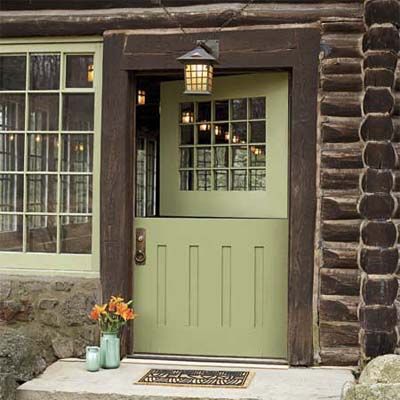
The interior of a Craftsman home is where the style shines. From 1901 to 1916, Gustav Stickley, a Wisconsin-born furniture maker, popularized this aesthetic through his magazine, The Craftsman. The publication offered house plans and showcased furniture, hardware, and textiles that defined the style.
Here are some characteristics of Craftsman interiors, as designed by Stickley:
- Built-in cabinetry and shelving that maximizes space efficiency
- Hammered-copper hardware that adds a rustic touch
- Homespun textiles that bring warmth and texture to spaces
- Natural stone fireplaces that serve as striking focal points
- Stained-oak furniture with simple, sturdy designs
These elements work together to emphasize natural materials and craftsmanship. The style’s enduring popularity is thanks to its ability to blend functionality with beauty.
A Central Hearth
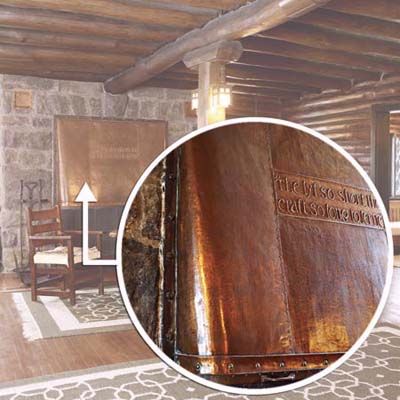
The fireplace is the heart of a Craftsman living room, serving as both a focal point and a gathering place. In Stickley’s 1911 home, Craftsman Farms, a hand-hammered copper hood adorns the fireplace and makes it a beautiful centerpiece for the room. On the hood is an inscription from Chaucer: “The lyf so short, the craft so long to lerne.”
Fireplaces in Craftsman homes are often decorated with intricate tile work and handcrafted mantels, emphasizing their role as a central, unifying feature of the living space. This focus on the hearth reflects the Craftsman ideal of home as a sanctuary, where form and function meet in a warm, inviting blend.
Lanterns
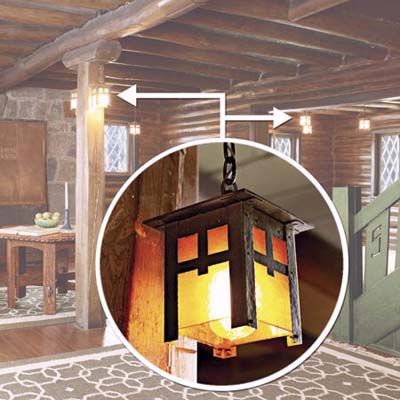
Lighting plays a big role in Craftsman interiors. The style often incorporates fixtures inspired by Japanese paper lanterns, as seen in the 50-foot-long, open-plan living room of Craftsman Farms. Stickley and his contemporaries, such as architects Charles and Henry Greene, adapted these designs using materials like copper and art glass instead of traditional bamboo and rice paper. This fusion of Eastern and Western influences is a hallmark of the Craftsman style.
Lanterns and light fixtures often feature geometric shapes and earthy tones to enhance the natural, handcrafted ambiance. These light sources create a soft, welcoming glow that highlights the craftsmanship and details of the design.
Exposed Joinery
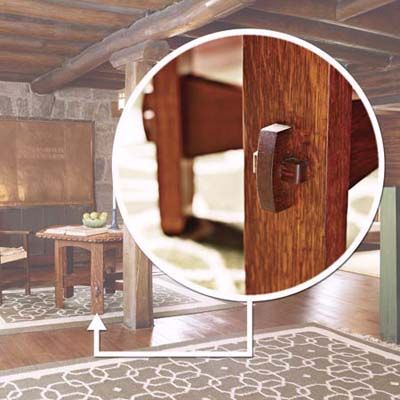
One of the most distinctive features of Craftsman furniture is the elaborate display of wood joinery. This can be seen in bookshelves, tables, and seating throughout Craftsman homes. A signature element of Stickley’s designs is the horizontal “key” that fastens exposed tenons, as shown in the table pictured. This attention to detail not only showcases the skill of the craftsman but also adds visual interest to the furniture.
Exposed joinery serves as a testament to the quality and durability of the construction, embodying the Craftsman principle that beauty and practicality should go hand in hand. Each joint and connection is made to be seen and appreciated for its artistry and skill.
Upholstered Tables
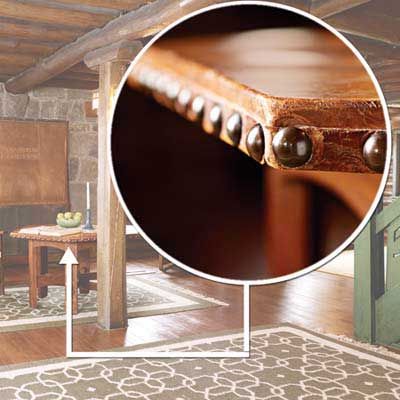
Craftsman furniture often features oversized tacks as a decorative and functional element. These tacks, which are sometimes the only visible hardware on a piece, secure leather upholstery and tabletops. This detail exemplifies the Craftsman principle of form following function, where even utilitarian elements are designed to be visually appealing.
The combination of wood and leather with metal hardware creates rich textures and visual interest, emphasizing the handcrafted quality and durability of each piece. Such tables are examples of how this style merges practicality with beauty.
A Carved Balustrade
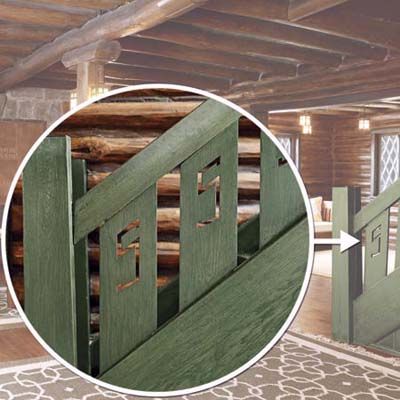
Stickley’s design philosophy extended beyond furniture to architectural elements within the home. The staircase balustrade in Craftsman homes often echoes the wide, flat wood supports found in armrests and chair backs. This creates a harmonious flow throughout the space, tying together the furniture and built-in features.
Carved balustrades, often featuring intricate patterns or natural motifs, serve as a visual link connecting different areas of the home. This creates an overall sense of unity and craftsmanship that is central to the Craftsman style, transforming staircases and railings into functional pieces of art.
Contemporary Craftsman-Style Products
There are many contemporary products that you can incorporate into your home to add a Craftsman touch. These examples help you marry the old with the new to create a timeless, cohesive design. Here are some items that can help you achieve the look.
Mantel Clock
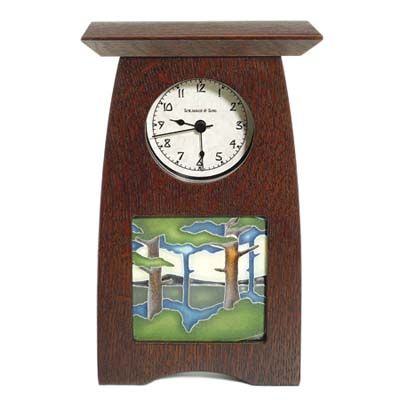
Clocks have a great old-world vibe that fits in with the Craftsman style. In this example, an oak casing with a 4-by-4-inch tile insert evokes the idea of a hearth, even when placed on a dresser. You can find mantel and wall clocks in antique stores, estate sales, and online marketplaces like eBay and Etsy.
Needlepoint Pillow
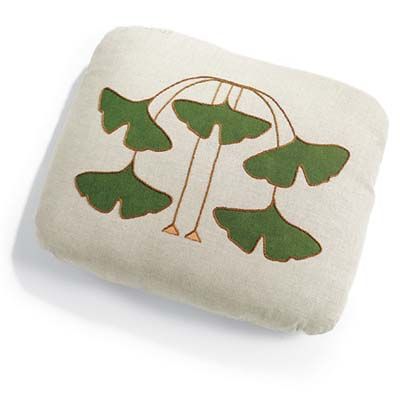
Hand-stitched textiles are popular in Craftsman designs because of their homespun look. A linen ginkgo-leaf pillow, like the one pictured, adds nature-inspired design to your space. If you or a family member can cross stitch or embroider, it’s easy to add art like this all around your house. You can also find them at thrift stores or sold by crafters online through sites like Etsy.
Natural Curtains
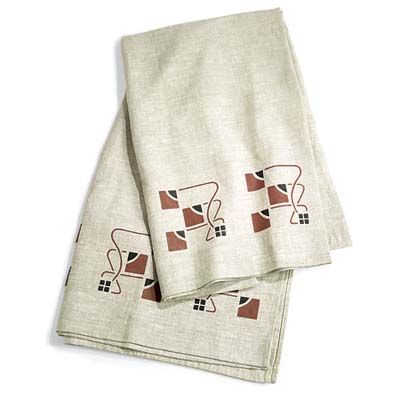
Geometric Art Nouveau patterns and designs that feature elements of nature are another great way to evoke the Craftsman style in your home. These printed linen panels show the overlap between different design movements of the early 20th century and would be perfectly at home with Craftsman decor. Similarly, you can use vine or leaf motifs on fabrics in your home to highlight the natural theme of Craftsman design.
Antique Mailbox
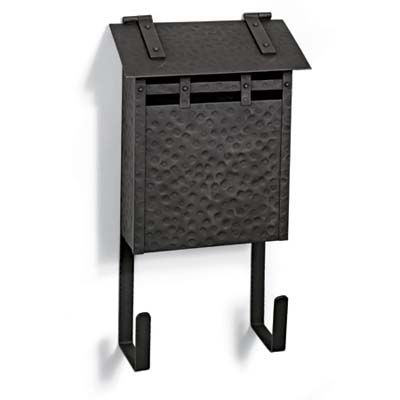
Bring your Craftsman design to the exterior with a mailbox in an antique copper finish. This small detail can make a big impact on your home’s curb appeal. Updating your mailbox to match your Craftsman style adds more character to your home and ties it into the thoughtful design that carries through to the interior. It’s a simple yet effective way to enhance the overall style and create a cohesive look from the outside in.
Stained Glass Porch Lantern
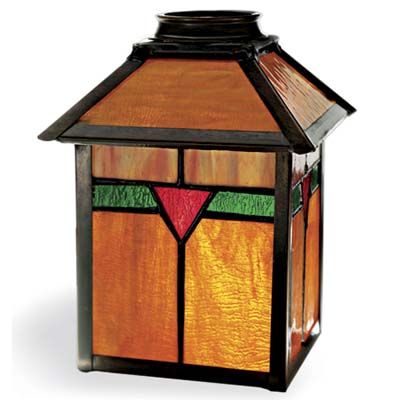
A stained-glass lantern is another way to add small details that enhance the overall warmth and character of the design. Porch lanterns with intricate stained-glass designs not only brighten your entryway but also serve as a warm and welcoming beacon for your home. These lanterns provide that classic touch of elegance and craftsmanship that ties into the Craftsman style.
Framed Art Tiles
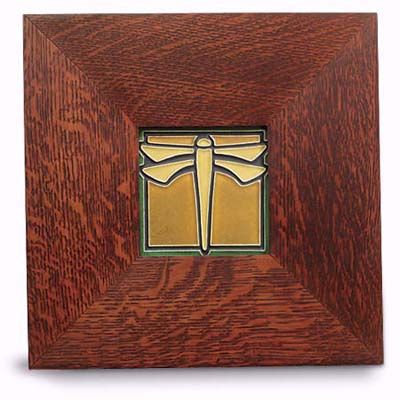
Framed ceramic tiles capture the movement’s enthusiasm for the natural world and elevate craft to the status of art. These decorative pieces can serve as focal points in any room. Art tiles, often featuring themes inspired by nature, are quintessential elements of the Craftsman style. Incorporate these beautifully crafted tiles into your decor to highlight the connection between your home and the outdoors.
Side Table
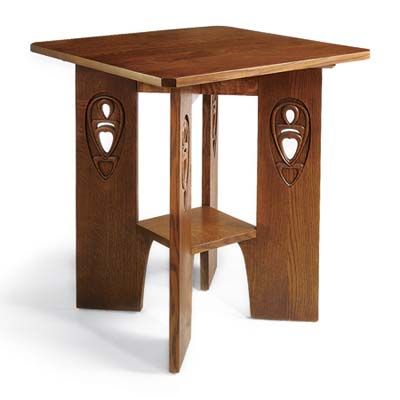
This reproduction end table in rich-grained oak with plank legs and patterned cutouts exemplifies the Craftsman style. The visual interest created by the wood grain and design makes it a standout piece. When choosing furniture for your Craftsman-style home, pick pieces that combine practicality and beauty with simple, natural finishes. You want something that has both a sturdy build and an elegant design.
Hammered Hardware
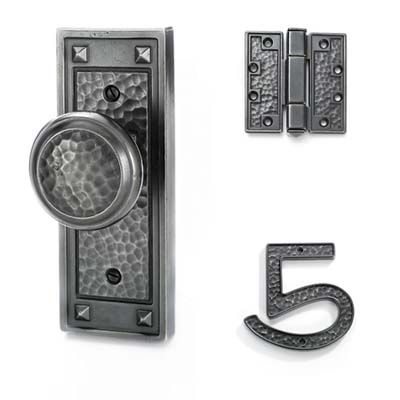
Authentic Craftsman-style hardware can transform any door and make it appear more purposeful and stylish. Hand-hammered pieces in characteristic shapes add a touch of artisanal craftsmanship to your home. From door handles to hinges and numerals, hand-hammered pieces add subtle yet significant touches of craftsmanship that enhance the overall look.
